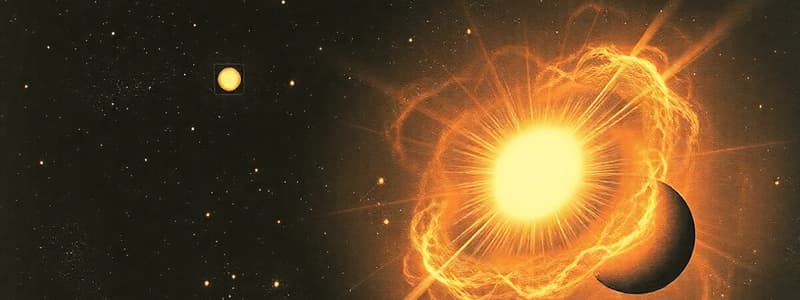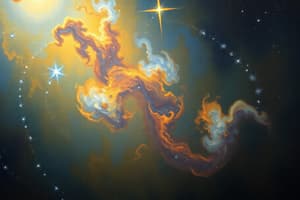Podcast
Questions and Answers
What is a key component required for a nova to occur?
What is a key component required for a nova to occur?
- A single large red giant star
- Multiple stars in a close cluster
- A black hole and a neutron star
- A dying star and a white dwarf in a binary system (correct)
How often do nova outbursts occur in the T Coronae Borealis system?
How often do nova outbursts occur in the T Coronae Borealis system?
- Approximately once every 100 years
- Approximately once every 80 years (correct)
- Approximately once every 10 years
- Approximately once every 50 years
What is the expected visibility of the upcoming T Coronae Borealis nova eruption?
What is the expected visibility of the upcoming T Coronae Borealis nova eruption?
- Visible with the unaided eye for several days (correct)
- Only through powerful telescopes
- Only during daytime with special sunglasses
- Only from specific locations on Earth
Why does the white dwarf in T Coronae Borealis survive each nova event?
Why does the white dwarf in T Coronae Borealis survive each nova event?
What does the nova explosion result from?
What does the nova explosion result from?
What type of celestial event will occur before September 2024?
What type of celestial event will occur before September 2024?
Where is T Coronae Borealis located in relation to Earth?
Where is T Coronae Borealis located in relation to Earth?
What visual phenomena will the nova explosion resemble?
What visual phenomena will the nova explosion resemble?
Flashcards
What is a nova?
What is a nova?
A sudden and dramatic increase in brightness caused by an explosion of a star.
What is a binary star system?
What is a binary star system?
A binary star system containing a red giant star and a white dwarf star.
What is a white dwarf?
What is a white dwarf?
A 'dead' star with a very high density and gravity, typically formed from the remnants of a red giant.
What is a red giant?
What is a red giant?
Signup and view all the flashcards
What is T Coronae Borealis (T CrB)?
What is T Coronae Borealis (T CrB)?
Signup and view all the flashcards
What is the process that leads to a nova explosion?
What is the process that leads to a nova explosion?
Signup and view all the flashcards
How can we see the upcoming nova outburst?
How can we see the upcoming nova outburst?
Signup and view all the flashcards
What will the nova outburst look like?
What will the nova outburst look like?
Signup and view all the flashcards
Study Notes
Nova Outburst Prediction
- A nova is a sudden, dramatic increase in brightness of a star, appearing as a new bright star.
- Novas typically occur in binary star systems, composed of a red giant and a white dwarf.
- Material from the red giant accumulates on the white dwarf, eventually causing an explosion.
T Coronae Borealis (T CrB) Nova
- T CrB is a binary star system approximately 3,000 light-years from Earth.
- It is known for periodic nova outbursts.
- The last outburst occurred in 1946.
- The system's red giant and white dwarf orbit each other tightly.
- The red giant loses mass, which then accumulates on the white dwarf.
- This causes high pressure & temperature on the white dwarf, leading to an explosion.
- The white dwarf survives each nova.
- The event will be visible to the naked eye for several days.
Prediction and Observation
- NASA predicts a nova outburst from T CrB sometime before September 2024.
- The exact timing is difficult to predict.
- The nova will be visible without any equipment for several days.
- Binoculars will enhance visibility for over a week.
- The outburst will appear as a bright star in the northern sky.
Studying That Suits You
Use AI to generate personalized quizzes and flashcards to suit your learning preferences.




